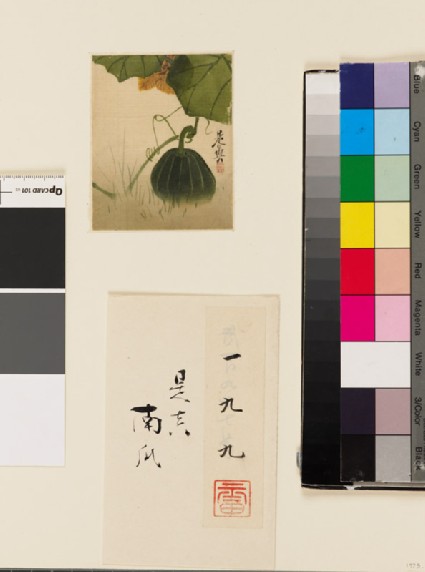Browse: 10610 objects
- Reference URL
Actions
Melon and leaves
-
Details
- Associated place
- Date
- possibly c. 1840s
- Artist/maker
-
Shibata Zeshin (1807 - 1891) (artist)Maruyama-Shijō School (active late 18th century - late 19th century)
- Material and technique
- ink and colour on silk
- Dimensions
-
mount 40.3 x 27.5 cm (height x width)
painting 8.7 x 6.8 cm (height x width)
- Material index
-
organic › animal › animal product › silk,
- Technique index
- Object type index
- No. of items
- 1
- Credit line
- Purchased with the assistance of the Friends of the Ashmolean, and Mr and Mrs J. Hillier, 1973.
- Accession no.
- EA1973.111
-
Further reading
Katz, Janice, Japanese Paintings in the Ashmolean Museum, Oxford, with an introductory essay by Oliver Impey (Oxford: Ashmolean Museum, 2003), no. 39 on p. 142, p. 85, illus. p. 143
Location
-
- currently in research collection
Objects are sometimes moved to a different location. Our object location data is usually updated on a monthly basis. Contact the Jameel Study Centre if you are planning to visit the museum to see a particular object on display, or would like to arrange an appointment to see an object in our reserve collections.
Publications online
-

Japanese Paintings in the Ashmolean Museum
This tiny painting of a melon has been deftly executed on silk. Such a large fruit, with even larger, broad leaves is an interesting choice for a diminutive composition. The dark green pigment of the vegetable has been painted over a lighter shade of green. This colour combination is reversed in the lighter-coloured leaves that have darker-toned veins. The strong dominant shapes and sharp diagonal formed by the leaves and flower at the top is a compositional device mastered by Zeshin.
It is difficult to date this painting, as with all of Zeshin’s works, although it is probably from the artist’s later career. The same combination of signature and seal is seen in a lacquer painting (urushi-e) album in the Yamatane Art Museum with Zeshin’s age, seventy-one, written before his name, making it a work of 1877 [see Itabashi Art Museum, Shibata zeshin ten: bakumatsu meiji no seika kaiga to shikkō no sekai, (Tokyo: Itabashi Art Museum, 1980), fig. 10]. At this later stage, Zeshin’s interest in the miniature became pronounced as evidenced in particular by his many lacquer painting albums [for example, a painted album dateable to 1881 of paintings of the twelve months in the Honolulu Academy of Art is 11.5 x 8.9cm, an album of ten lacquer paintings also in Honolulu measuring 12.1 x8.7cm is dateable to the late 1870s, and an album of eighteen lacquer images from the Khalili collection of c. 1879-90 measures 11 x 8.5cm. For the first two examples, see Howard Link’s exhaustive study, The Art of Shibata Zeshin: the Mr and Mrs James E. O’Brien Collection at the Honolulu Academy of Arts (London: R. G. Sawers Pub., Honolulu: Honolulu Academy of Arts, 1979), 93-6, 90-92. For the best example, see Joe Earle, Shibata Zeshin: Masterpieces of Japanese Lacquer from the Khalili Collection (London: Kibo Foundation, 1997), 59-68]. We can also see a move to the miniature in Zeshin’s lacquer objects, such as several inrō dateable to his later life [Earle, 31-56 and Link, 144-5].
Yet there are some inconsistencies with the chronology beginning to form of Zeshin's career. Seals with the singular character of ‘Shin’ as seen here are thought to have been used by Zeshin in 1832. The signature on Melon, however, most closely resembles a work of the mid 1840s or slightly later [see Link, 187-8, where the seal on the Ashmolean piece is the same as the one reproduced as number 22. The signature resembles that on Symbols of the Weavers’ Festival, catalogue number 12, page 52]. Nevertheless, Melon is a charming work by Zeshin, published here for the first time, which will add to our skeletal understanding of the artist’s career.
© 2013 University of Oxford - Ashmolean Museum

